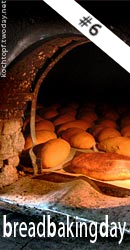
Having successfully met last month's challenge for BreadBakingDay #5, I have been eagerly awaiting the next event. This time, for BreadBakingDay #6, our hostess is Eva, from Sweet Sins, and the challenge is to create a shaped bread. Time for research, because I didn't want to make just any old shaped bread. So, I found a book in the library that had a wide variety of choices for breads of all kinds -- Celebration Breads: Recipes, Tales, and Traditions by Betsy Oppenneer (2003). My choice was definitely a challenge in the shape department -- Colomba di Pasqua, an Italian Easter bread that is shaped like a dove of peace. Or, in my case, like a very large, puffy storm-stressed bird. Well, just use your imagination.

This bread can be prepared in several ways -- by hand, by mixer, by food processor, and by bread machine. The book also gives diagrams showing how to do the shaping. To save space, I will describe my adaptation of the mixer method and the shaping method, as best I can.
Colomba di Pasqua (adapted from Celebration Breads)
Makes one very large loaf (15" by 18")
Dough:
1 1/4-ounce package active dry yeast
1/4 cup warm water (110 degrees (F))
1 1/2 cups milk
1/4 cup unsalted butter, softened
1/2 cup almond paste, crumbled
1 teaspoon vanilla extract
3 large eggs, lightly beaten
1 large egg yolk
1 tablespoon finely grated lemon zest
1/4 cup granulated sugar
1/2 teaspoon salt
4 to 5 cups unbleached all-purpose flour
Topping:
1 large egg white
1 cup thinly sliced almonds
1 tablespoon granulated sugar
In the mixer bowl, sprinkle the yeast onto the warm water to soften. Heat the milk to 110 degrees (F) and add it to the yeast along with the butter, almond paste, vanilla, eggs, egg yolk, lemon zest, sugar, salt, and 2 cups of the flour. Use the mixer paddle and beat the mixture on medium-low speed for 2 minutes. Gradually add the remaining flour, about 1/4 cup at a time until the dough begins to pull away from the side of the bowl. Change to the dough hook. Continue to add flour, 1 tablespoon at a time until the dough just begins to clean the bowl. Knead 4 to 5 minutes on medium-low speed.
Place the dough in an oiled bowl, coating the entire ball with oil. Cover and let rise for about 1 1/2 hours. (The almond paste may keep the dough from doubling in size.)
Turn the dough out onto a lightly oiled work surface and divide in half. (My suggestion would be to make one half somewhat larger than the other half.) Shape each half into a smooth ball, cover, and let rest for 5 minutes. Shape the smaller ball into a half oval, 12 inches long and 4 inches wide at the center. This will become the wings. Place it in the center of a parchment-lined baking sheet. Flatten the center slightly so that it won't be too thick when the rest of the dough is placed on top.
Shape the larger ball into a triangle with an 8 inch base and 16 inch sides. This will be the head and body. Center the triangle onto the flattened part of the wing piece. Fold the narrow top part over to the right to form the head. Pinch a bit of dough with your fingers to make a beak. Fold the bottom end towards the left, twisting it to form the tail. Then, using scissors, cut 2-inch slits along the bottom edge of the tail and wings. Fan them out to make feathers.
Cover and let rise for about 45 minutes.
About 10 minutes before baking, preheat the oven to 375 degrees.
While oven is heating, decorate the bird. Beat the egg white until frothy and lightly brush the dough. Arrange the sliced almonds in a slightly overlapping pattern on the tail and wings to simulate feathers. You can use a currant or raisin for the eye. Carefully brush the almonds with the remaining egg white and sprinkle with sugar.
Bake for 25 minutes or until the internal temperature reaches 190 degrees (F). Remove the bread from the oven and baking sheet, and place on a rack to cool.

May be frozen for up to 6 months.
Many thanks to Eva for hosting this month's event, and many thanks to Zorra at 1x umrühren bitte for creating it. If you have a chance to find this cookbook, you will enjoy reading the stories about different celebration breads from around the world.
My only problem now is figuring out which part of the dove to eat first.






4 comments:
Your dove is too beautiful to eat! :-)
How lovely! Maybe I should try this one for Easter, it's quite a challenge. Thanks for participating!
Wow, this is really spectacular! You did a wonderful job an a very intricate shape.
Beautiful bread!
Post a Comment